This post was contributed by Mr. Lionel Khaton. A native of New Orleans and avid family historian, Mr. Khaton previously contributed “The Quest to Find My Family,” a post about his Quétant/Khaton research and his observations on the life of Civil War hero André Cailloux. We are glad to publish Mr. Khaton’s article and hope that it will encourage others to research and write the stories of their lives, families, and communities.
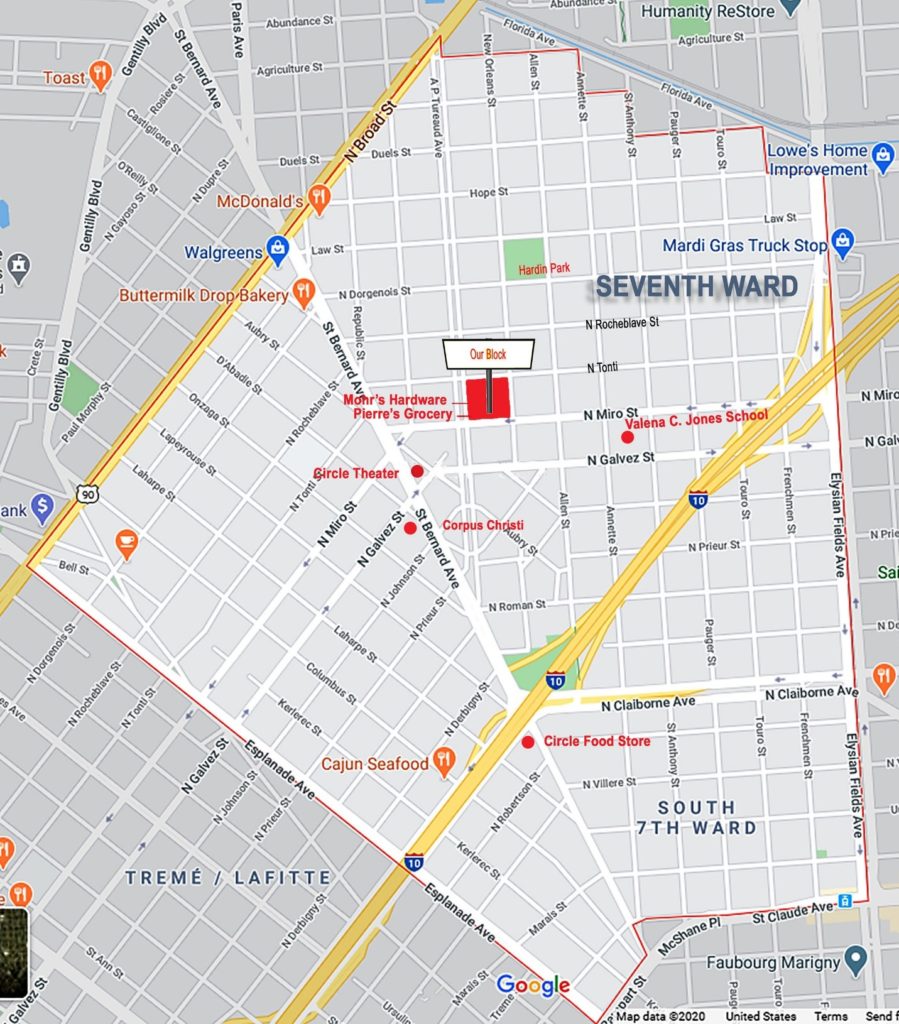
My first eight years of life were spent in the Seventh Ward in New Orleans from 1947 to 1955. There have been so many characterizations of this ward that it has become something of a legend in the lore of the city. This period was a significant one in the history of the country and the city. Black men like my father were returning from World War II. Their expectations of life in the United States had substantially changed.
The term “creole” comes up whenever the Seventh Ward is mentioned. These WWII veterans returned to a New Orleans where both whites and blacks could consider themselves creole; indeed, many whites felt that one must be Caucasian to be creole. Much of the social formulations about what a creole is have been informed by sociopolitical developments in the city during the postbellum period. (See “Seventh Ward Civic League – its History and Accomplishments” published by CreoleGen on June 8, 2013.)
However, the returning vets were looking to the future. They wanted a brighter future for themselves and their families. They wanted more opportunities and felt their service to the country gave them a right to full citizenship. These desires were manifested more on the behalf of all black people rather than creoles. Creoles of color lived in all parts of the city; however, the Seventh Ward had the largest concentration. The ward became prominent because of the preeminent leaders like A. P. Tureaud resided there. The post-war economy was expanding. Blacks in New Orleans were known to excel in the trades: carpentry, brick laying, masonry, etc. My father was among this group as were many of his friends. They returned seeking decent housing and employment opportunities.
DAILY LIFE
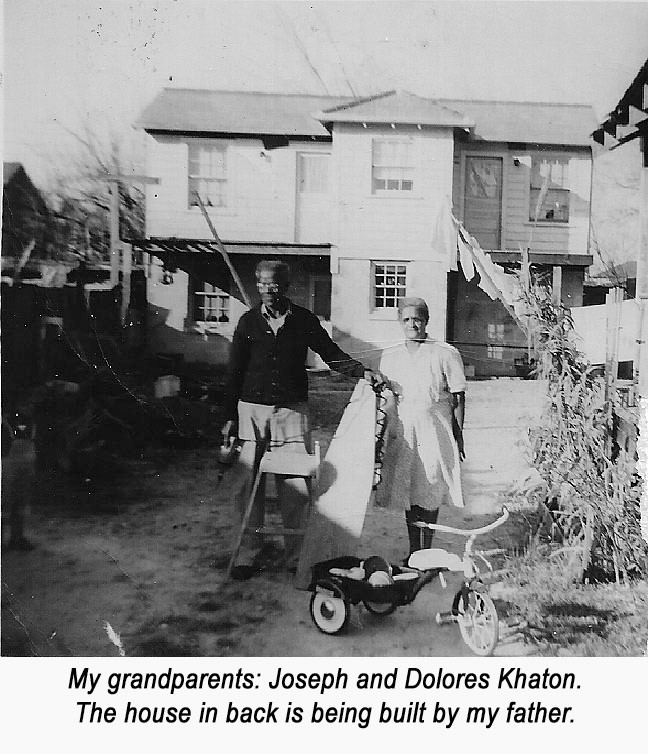 My grandfather owned a shotgun double house on a large lot on N. Miro Street between London Avenue (now known as A. P. Tureaud) and New Orleans Street. My father built our house toward the back of that lot. At one point it was like a Khaton enclave. We lived in the new house, my grandparents along with my aunt and her family lived on one side of the double while my uncle and his family lived on the other side. Many families lived near one another in those days.
My grandfather owned a shotgun double house on a large lot on N. Miro Street between London Avenue (now known as A. P. Tureaud) and New Orleans Street. My father built our house toward the back of that lot. At one point it was like a Khaton enclave. We lived in the new house, my grandparents along with my aunt and her family lived on one side of the double while my uncle and his family lived on the other side. Many families lived near one another in those days.
Life for kids couldn’t be better. The neighborhood was like a close-knit community. This allowed us to explore an expansive portion of it even though we were quite young at the time. Our activities tended to be seasonal. In the fall we’d break out our ‘skating trucks’ (skate mobiles to the more sophisticated). Our dads usually made these for us. These were scooters made from an old skate and wood. We’d get on these and roam the neighborhood. Our excursions started on Miro St. and passed Diaz Shoe Repair. Mr. Diaz was a diminutive old guy with glasses perched on his nose. He wore those old-time sleeve garters on his shirt sleeves. His store always had the smell of leather and glue. Once passed the shoe repair shop it was around the corner to London Avenue. Mr. Pierre’s corner grocery was there. We were often sent to Pierre’s for milk and cigarettes and occasional dry goods like twine or string. A right turn on London took us to the middle of the block to Mohr’s Hardware. It was a hardware store but sometimes had a model airplane or a wagon displayed. We pushed on to Tonti St., where my great grandmother’s house sat in the middle of that block. We continued up London until we reached a burlap bag factory. It had a smell like hay.
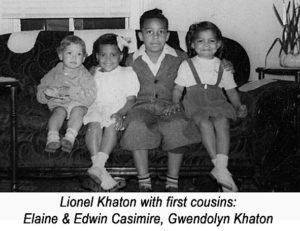 Of course, Christmas was the time when we all brought out our presents. We’d be out on the banquette (sidewalk) enjoying the loot. If it was cold, we were like a group of snot-nosed kids outdoors enjoying the Season. There were also the trips to Canal Street where you could watch the automatons in Maison Blanche’s window.
Of course, Christmas was the time when we all brought out our presents. We’d be out on the banquette (sidewalk) enjoying the loot. If it was cold, we were like a group of snot-nosed kids outdoors enjoying the Season. There were also the trips to Canal Street where you could watch the automatons in Maison Blanche’s window.
Winter also meant school and school was where you widened your scope and your number of acquaintances. Our family was Lutheran, so I attended St. Paul Lutheran School from first through third grades. This allowed me to attend school at younger than the required entry age at the time. I enrolled in Valena C. Jones School for fourth grade. It was the primary public elementary school in the Seventh Ward, Corpus Christi was the main Catholic school. I would walk to my grandmother’s house for lunch. She would pull out her handkerchief, which was tied around a stack of coins, take out a quarter and tell me to go across the street to Mr. Bob’s store and get a nickel’s worth of lunch meat. “And bring back my change”, she would say. I’d follow her orders whereupon she’d make me a luncheon meat sandwich on French bread. Sometimes I’d go across the street from school to a little place owned by an elderly couple called Vance’s Sandwich Shop. In those days kids at school would sometimes sell Ritz crackers or hand suckers for about a nickel normally. Physical Education classes usually entailed square dancing.
As spring approached the neighborhood kids all wanted kites to fly. Just like the skate mobiles, kites were rarely purchased from the store. Our fathers usually made them for us. Kite flying days rarely lasted more than a week since most of us had gotten our kites hung up on a power line or in a tree. As May approached Jones School began gearing up for its annual May Day pageant which was usually held at Xavier University’s field. The program was replete, including the maypole ceremony performed by the girls. It was a decorated pole, around which the girls would dance while holding long red, white and blue ribbons that are attached to the top of the pole. During the dance they would weave the ribbons to the pole.
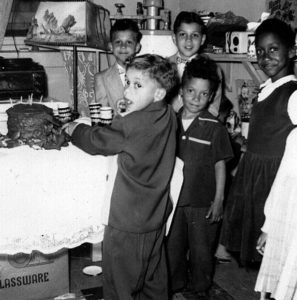
Back: Wayne and Wilson Picou
Front: Lionel Khaton, George Cuiellette, Gloria Bloom
Glory be! It’s summer and school is out. The refrain from all the adults to their kids is, “Go outside and play!” A New Orleans day is hot and humid. After a while we’d laugh and kid one another saying, “You’ve got grammaw beads!” These are the rings of dirt that form in the sweat in creases around one’s neck. Sometimes we would defy our parents and venture as far as Hardin Park some five blocks away. Or, we would cross Miro St. and hook up with Narcisse Marchand or ‘Lil’ Joe Jones. His dad, Joe Jones was the closest thing we had to a celebrity in the neighborhood. It was said he discovered the Dixie Cups. Most folks remember him for his hit song “You Talk Too Much”.
There was no air conditioning in those days. As the shadows lengthened with the lowering sun folks would begin to come out and sit on their porches. We kids engaged in games like ‘Red Light’, ‘Dodge the Ball’ and other amusements we often made up. Some people took walks. This is where the ubiquitous New Orleans term ‘Howz ya mom’n’dem’ could be heard preceded by ‘Even’in’. We played many of our games on the steps of the Brown’s house since their steps spread between both sides of their shotgun double. As dusk faded into night people began retreating into their homes. You’d hear an occasional call for a kid to come in. Night fell upon the neighborhood.
There is a short period of silence after everyone has gone inside. Perhaps it was suppertime, or they were just pondering events of the day. Then the night sounds began. You could hear rhythmic sound of all the window fans. Sometimes you’d hear a cricket or two. The sub-tropical climate of the city would also carry smells. Sometimes it was the sweet smell of flowers wafting through the air; sometimes it was the smell of cooking. These were the things that ended the day.
Early Saturday morning I would head over to the Cuiellette’s grandmother’s house to watch television. Mrs. Martin was the first person on the block to get a TV. We’d watch Mighty Mouse and Terry and the Pirates before heading outside. It wasn’t long before my folks purchased a set of their own. There was only one channel: WDSU-TV, Channel 6. We managed to witness a couple of other firsts back then. We saw Miro St. and London Avenue get paved.
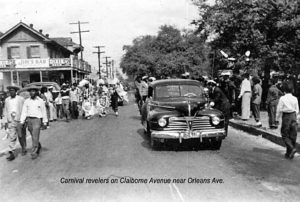 Then, of course, there was the big celebration of the year, Mardi Gras. During this time, you could wake up and look out of the front window and see maskers making their way to Claiborne Avenue. The routine at our house was to have my dad cook up his recipe of beignets, while my mother got food together to go into the car. The great meeting place for blacks in the Seventh Ward, indeed blacks from all over town, was to gather on the neutral ground on Claiborne. It was one big long picnic between Elysian Fields and Orleans Avenue. Folks would park their cars on the boulevard and have a giant tailgating party. There were maskers of all sorts: the men in the skeleton suits; the Baby Dolls; and the Indians. There were the truck floats and an occasional float from Zulu (back then Zulu was less disciplined). Some people would walk to Canal St. to catch Rex.
Then, of course, there was the big celebration of the year, Mardi Gras. During this time, you could wake up and look out of the front window and see maskers making their way to Claiborne Avenue. The routine at our house was to have my dad cook up his recipe of beignets, while my mother got food together to go into the car. The great meeting place for blacks in the Seventh Ward, indeed blacks from all over town, was to gather on the neutral ground on Claiborne. It was one big long picnic between Elysian Fields and Orleans Avenue. Folks would park their cars on the boulevard and have a giant tailgating party. There were maskers of all sorts: the men in the skeleton suits; the Baby Dolls; and the Indians. There were the truck floats and an occasional float from Zulu (back then Zulu was less disciplined). Some people would walk to Canal St. to catch Rex.
Things seemed to begin changing as the mid-fifties approached. Many black families were leaving New Orleans. They had looked at other places and seen more opportunity. Economic prospects were particularly alluring. The Brown family were the first I knew to pack up and head for California. Other neighborhoods were attracting many who stayed in the city. The development of Pontchartrain Park financed by Rosa and Charles Keller and Edgar and Edith Stern attracted many black families. It also attracted my father since he had landed a position in the Post Office that offered a steady paycheck. We left the Seventh Ward in 1955.
CONCLUSIONS
The lives of people of color in the Seventh Ward are not significantly different from folks in other areas of New Orleans. It does seem that leadership of the African American community coalesced in this ward between the late nineteenth and early twentieth century. In their book, Creole New Orleans, two authors have offered this explanation:
This culture was based on a separate language community with its own folkloric, musical, religious, and historical tradition. Unlike the Gullah dialect, which survived in the isolated Sea Islands off the coast of South Carolina and Georgia, the Louisiana creole language, created by slaves brought directly from Africa between 1719 and 1731, survived widely in southern Louisiana until World War II and is still spoken by tens of thousands of people, white as well as black, in some parts of the state.
Throughout the Americas, the word creole has been redefined over time for social reasons and has [had] many meanings. It derives from the Portuguese word crioulo, meaning a slave of African descent born in the New World. Thereafter, it was extended to include Europeans born in the New World.[1]
In today’s world it appears to be representative of a culture above all else.
Lionel Khaton
Notes: [1] Arnold R. Hirsch and Joseph Logsdon, Creole New Orleans: Race and Americanization (Baton Rouge and London, 1992)), 60.



Mr Khaton,
Thank you for sharing your story! So many family stories and family histories lay in each of those city streets and businesses you mentioned. I throughly enjoyed seeing it through your words and living it through your memories.
Thank you.
Great article Lionel. Brought back memories of my growing up in the 6th Ward (Treme) until my dad bought a house in Sugar Hills (Gentilly) in 1959. Thanks for the memories.
Many thanks to Lionel Khaton for writing this essay and to Creole Gen for the publication. It is a wonderful article that brought back good memories. I hope Mr. Khaton will write another article. Merci, Madame Trevigne
Thanks Mike.
Love reading his story. It brought back so many fond memories since I grew up not that far from him on New Orleans St between N Dorgenois and N Rochblave. I went to VC Jones also.
Mr. Khaton, I enjoyed your article. My grandmother was named Selonie Quetant McLaine also living in the seventh ward. Does that name ring a bell?
Yes, the Quetant name is part of my family heritage. I’d love for you or a relative to take the ancestry.com DNA test. I have a test I can make available to you.
Really enjoyed your article. Felt like my dad was talking to me. My grandparents lived on Tonti st. Maybe you interacted with some LeCesne’s back then. Thanks for your perspectice on the 7th Ward.
Diane LeCesne was a classmate at Xavier Prep and the University.
As my memory serves me, there was a family of LeCesnes that lived on Frenchmen St near Galvez St. Am I correct?
Can’t wait to read this! Thanks for all your great work!
Nice article. I am surprised that the Autocrat Club was omitted from the map illustration. Only because my Grandparents lived at 1705 St. Bernard, near Derbigny Street.
Yes, that was an oversight on my part.
Maypole twining was held at Dillard University when I attended Jones schooL My class was the first to twine the maypole with boys and girls. This article brought back many good memories of the SEVENTH WARD
Truly enjoyed your article. I too, grew up in “The Seven” as you called it. I was a boy in the 60’s and 70’s. It was then, still a great place to grow up. We played all day and went home when it got dark. Rode bikes all over town, played sports in the street. Frequented the neighborhood sweet shops.
As I got older, as many neighborhoods did, things began to change, not all for the better. We moved out in the mid 80’s, but who I am today is in many ways due to my upbringing in “Creole Heaven”, the 7th Ward.
Although I didn’t grow up in the seventh Ward, your story brings back a whole bunch of memories. I feel privileged To have grown up in the 50s and 60s in New Orleans. For me it was a wonderful life experience. Thanks for the memories buddy.
Thanks Alex. We still have The Park and Prep together.
Thanks for bringing me home. I grew up in the 60’s and 70’s in the 7th ward. Pauger, St Anthony, Annette, Republic, and Broad were some of the streets where I lived. My father Ronald Egana, Sr. was a well known barber. We both attended St. Augustine.
Your dad was my barber for several years.
He was everyone’s favorite. 🙂
I spent many Saturdays in your Dad’s barber shop.
And, I’m sure I had the pleasure of sweeping up your hair. LOL
Your article brings back great memories. My father had a drugstore on Annette St, Peete Pharmacy. I taught at Rivers Frederick for many good years. Had many games in Harden Park. I knew the area very well. Thanks for the trip back in time.
My Uncle did his pharmace intership at Peete’s Pharmacy. I was at Rivers Frederick when you were there. I finished Prep with Patricia Peete, who, I’m guessing, was your sister.
Hi Shirley..
Such a pleasure seeing your name and your background and I feel compelled to connect. My name is David Harold. I was Cleveland’s roommate and close friend at the University of Detroit. You may not recall; but, I also have fond memories of meeting your family. I am hoping that you will see this note and message me at dharold00@gmail.com. PLEASE DO.
My family moved to Treasure St in 1959 around the corner from Peete’s Pharmacy. My brothers and I played baseball with the Gentilly Warriors under Coach Penny. So familiar with all of the landmarks mentioned in Lionel’s essay, but we did not meet until I attended Xavier University of LA.
Michael, was your dad named Walter Glapion?
No my dad was Armand Glapion. Jr. We lived on N. Dorgenois St. Walter was a cousin and his family lived on N. Rocheblave St. next door to Clyde Kerr’s family and across from the Baquet family.
Well I guess that makes us cousins. Walter was my grandmother’s brother. Her name was Etna Glapion.
It was enjoyable to read your account of growing up in the 7th Ward of New Orleans post WWII. Your rich history was heartwarming and the families involved were strong and watched out for one another. This article gave me interesting insight to your days of being reared in New Orleans.
Some really nice memories, Mr. Khaton. I grew up 2327 London Ave in the 40s and 50s. My father, Earl, had a bakery and a sweet shop called Shirleys for Sweets where he sold candies, ice cream and snow balls. He would let the kids in the neighborhood name the syrups after different fighters. Some, over the years were Jersey Joe for spearmint, grape was Schmeling, pineapple was Billy Conn and strawberry was Joe Louis. His best sellers were Joe Louis and Jersey Joe. However, he had problems selling Schmeling and Conn. It was a good time.
Mr. Khaton, your article brought back sweet memories of the 7th ward. Mrs. Martin you referred to was my grandmother and George Cuiellette is my 1st cousin.
I was very close to the Cuiellette family. We remained good friends even after our families moved to Pontchartrain Park. I just spoke to George a few weeks ago to see how he was managing in this Covid-19 crisis.
Lionel,
Thank you for soooo many great memories. Experienced many of the haunts you mentioned. Two of my favorites included (1) all of my student days at Valena C. Jones School especially, May Day Pageant & Girl Scouts and (2) stopping off at the Vance Shop on Miro Street to buy all kinds of things….the store was a modern day K-Mart.
Thank you so much for the article Mr. Khaton. We lived in “The Cut” off St. Bernard Avenue on Old Roman Street. From there we moved to New Orleans Street between Duels and Industry. Mr. Alexis, Manuel Cahier (sp?) and Adolph DuConge cut my hair. I attended Valena C. Jones. I can remember old women in the neighborhood still speaking Creole French. How rich our experiences were. I’m glad the 7th Ward is being written about, documented, researched and appreciated.
I am from the 7th ward, we lived in the St. Bernard Project, attended St. Mary’s Academy. My grandparents lived directly across from Jones School. My family was Courseault and LaCroix . Someone said Adolph DuConge was their barber. He was my godfather . I love New Orleans.
Lionel, I really appreciated the memories. Elaine Casimire was my classmate and Mrs. Peete taught me at River’s Frederick. I grew up on New Orleans St. My neighbor was the niece of Ms. Owens who owned the Beauty shop on London. I am related to the Glapions. I had relatives on Pauger St and throughout the 7th ward. So many of the names of respondents are so familiar to me. I could go on and on about the names mentioned in your story.
I was just telling my husband how we made skate boards and did our own repairs on our bicycles.
Just this week I started writing what I called “My Memories” to give to my children and grandchildren so that they would know as much about me growing up and how life was so good in spite of not having much and being faced with the socital issues of that time. Thanks again for the memories.
Lois,
How are you related to the Glapions? My father as Armand Paul Glapion, Jr and everyone knew him by his nickname, Piety. Would like to get more information from you as this site has been so informative as recipients either submit Posts or reply.
Hi Michael. My great Aunt, Olivia Vigne, 1894-1941, married Armand Paul Glapion at the age of 16 on January 8, 1909. They had three children, Almonda, Juanita and Roy. If you have any pictures of Olivia, please let me know. Lois
Good Morning Lois,
Unfortunately I do not have any photos of Olivia. I never met her and only knew Roy. I also knew he had 3 siblings, a brother and two sisters but never met any of them when I was growing up. My grandfather, Armand Paul Glapion, Sr. had five children with his second wife, Lydia Lambert.
We had a Glapion Family Reunion in 2016 of the families of Armand and Lydia’s five children. I have a document that my sister in law prepared for the reunion that I would gladly share with you if you would send me an email address.
Do you live in New Orleans? If so I would welcome the opportunity to meet you.
Hi Michael
I am from New Orleans but I live in Baton Rouge. I really would appreciate a copy of any documents you may have. My email is Loismayho@gmail.com. Once this virus is over and I come to New Orleans, I will contact you in advance. I look forward to meeting you.
Lois
You mention hand suckers. I remember hand suckers and man suckers molded on wooden popsicle sticks and sold in glassine bags. A corner store in my mother’s old neighborhood, Nick the Greek’s, sold them. I would like to know more about this candy, if anybody can point me in the right direction.
Mr. Khaton,
Thank You! Your accounts of growing up on the same street I grew up on, even after 20+ years later, still brought back great memories. I’m currently writing a book/memoir about growing up in the “7th” between 1980-1997. My family home was 1839 N. Miro St., right on the corner of New Orleans Street. Ms Ruth Ventress is my Grandma. I too attended V. C. Jones.
Reading all of it was refreshing because I truly enjoyed being a kid running the streets of the 7th ward.
Thank you Keith. It was a great neighborhood.
I lived in the 9th ward but went to Albert Wicker for 8th grade and also attended Grace Methodist Church on Prieur and Iberville St. Those were fun days back then even though my brother and I were bussed to school as there were no junior highs for us to go to at that time.
I remember selling hand suckers and head suckers at Lockett school. That was so much fun. Patricia LeBlanc who lived in the Lafitte Project and was friends with Brenda Thornton always had parties at her home and would invite my brother and I to attend.
After 8th grade was over at Wicker, I attended Carver Jr. High until I graduated in ’62. Since 1971, I have been living in Los Angeles but always enjoy NOLA when I return.
Just reread your article, Lionel, and enjoyed your colorful and detailed memories. I lived at 1342 Columbus St until 1948 where McDonough 35 was, then we moved to Willow St. Your neighborhood had stores and families with different names, but very similar to those in mine. Thanks for putting it all down in words and pictures. Helps it last for future generations and refreshes it for my generation.
Here’s some other spots
Prouts seafood – London Av
Taylor’s snowball stand – 2500 block of Allen st
Lawson’s meat market – Law St @ Allen
Thornhill drugs – Hope & London
Thank you,
I am trying to find pictures of my GGGG Grandfather Jean Francois Girod the second and his Mother a freed slave from France. I hope you are doing well with all that is going on in the world now. God Bless you.
Hi Charlotte,
Getting a photo of your 4th Great grandfather will be an extremely difficult task. It’s a tough task for an African-American. He may be Caucasian if you do find it.
All’s well on my end. Hope the same for you.
Lionel
In the late 60’s/early 70’s, my father had a corner grocery store, “Charlie’s Place”, on the corner of London and Dorgenois. Anyone have any memories of my dad or his store?
GOD BLESS! THANK you for writing about the Seventh Ward and it’s heritage !
I’ve been spending the day working on my family tree and it was so great reading this as I’ve been wondering a lot about what life was like for my grandparents/aunts/uncles in that neighborhood. George Kaufman is my grandpa btw, hehe hi fam!